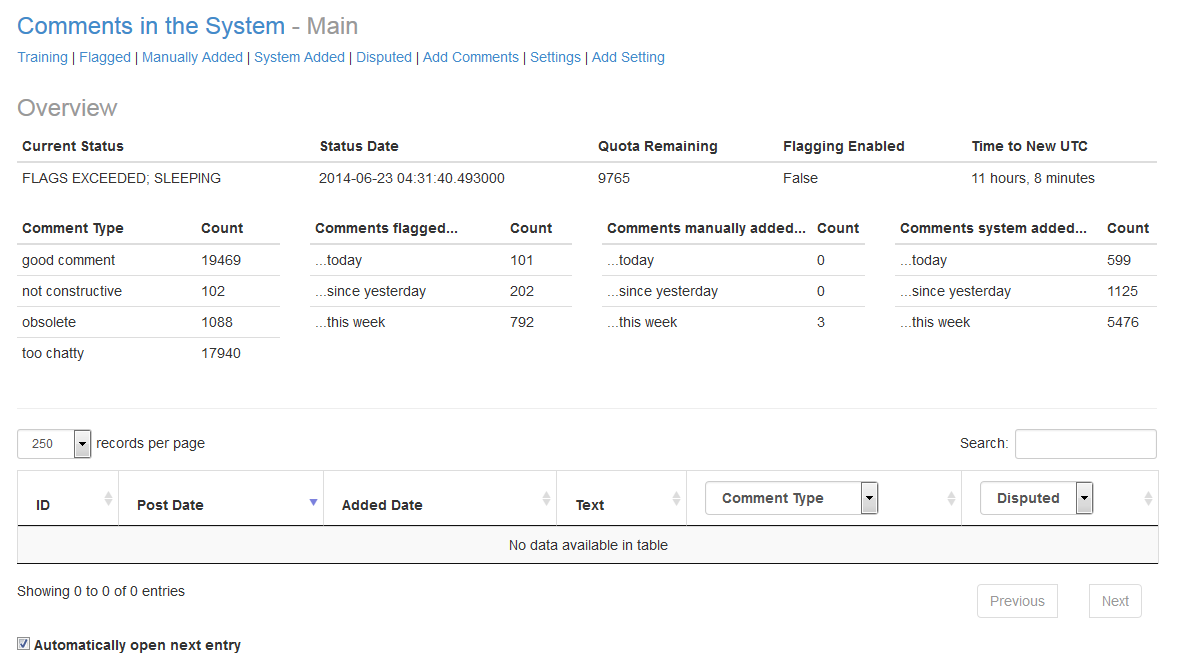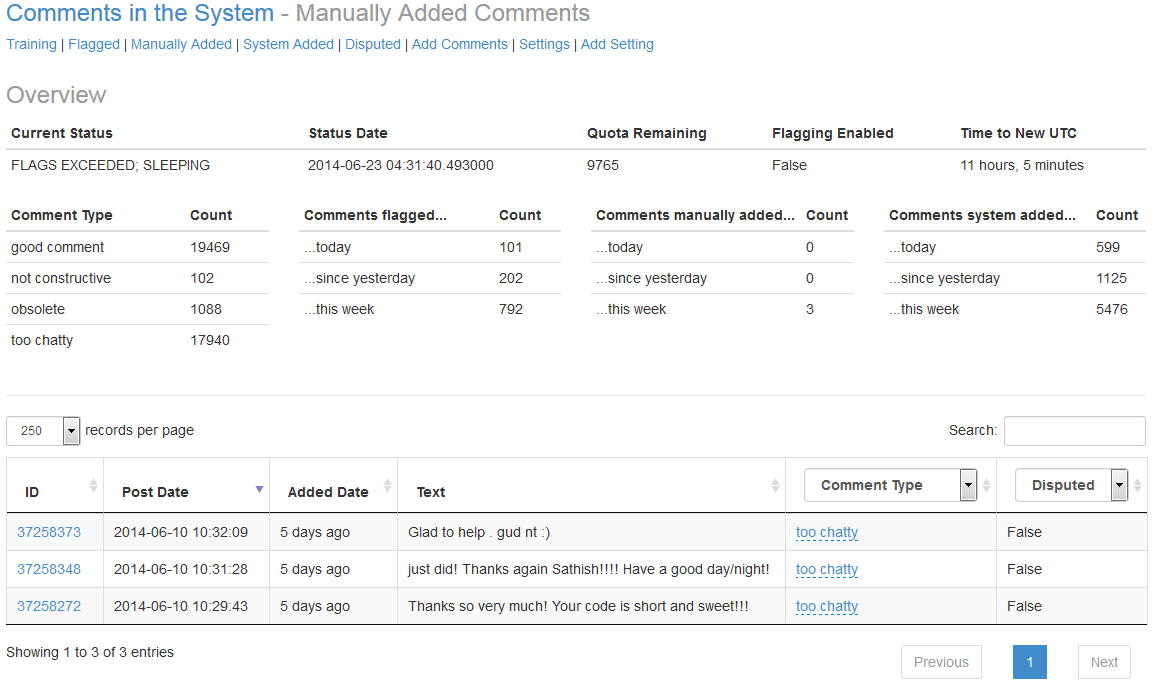Automated Stack Overflow Comment Flagging application
Stack Overflow's model of limiting comments that don't contribute to the problem or solution at hand is admirable. Users are able to comment everywhere once they have reached 50 reputation points. Prior to this, users can comment only on their own posts. Despite the requirement for a small amount of reputation, there is still countless pointless comments added hourly.
This project is designed help clean up comments, in a small way. Unfortunately, I am limited to only 100 comment flags daily, thus will only be able to help clean those flags. Additionally, the task of flagging the same comment types becomes monotonous. Fortunately, this means I should be able to automate it.
I have three major goals in the development of this project:
- Machine learning; I should be able to use a simple Naive Bayes (and potentially other) algorithms to teach a system my flagging history. For historical purposes, prior to bringing this system online, I have approximately 9,500 comment flags and only 34 of those have been declined. My goal is to maintain this high rate of accuracy, while still flagging the maximum number of comments I am able to a day.
- Flask; I will develop a basic web control panel that allows me to quickly see an overview of the system, adjust settings, and adjust flag types the system has made. These adjustments will be used when the system is retrained, based on recent flags.
- Stack Exchange API; None of the automated flagging would be possible without utilizing the Stack Exchange API. I will be using a very heavily modified version of pyso.py and se-api-py for this API work.
Initial Set up
- Download the repository
- Run
pip install -r requirements.txt - Run
python -m textblob.download_corpora - Run
python populate_database.pyfor inital table creation (it will be in an SQLite Database) - Launch the web control panel and navigate to the Settings; Fill in the appropriate values for your API information
- You are now ready to continue
How to run the web control panel:
- The Flask Control panel can be run from Windows by executing the
run_flask.batfile. If it is run within Linux, then thePYTHONPATHneeds to be modified to include the root of this project and then you can executepython FlaskPanel\app.py. This modification is needed so that modules at a sibling level toFlaskPanelcan be included.
After the above command is executed, you can visit localhost and see the panel's main dashboard
This gives a very nice overview of the system's current status. From here main of the break downs are selectable and will show the comments associated with that data point. For example, by clicking on the "Comments manually added..." -> "...this week" data point, you can see the three comments manually added to the system this week.
Settings:
The System has several dynamic settings, available in the "Settings" subheader link.
classifier_algorithm- Setting value that corresponds to whichTrainingAlgorithmto utilize. ThisTrainingAlgorithmwill have a Training File Location that is set to the full path ofCLASSIFIER_NAMEdefined inNaiveBayesV2current_status- The current status of the flagging application. This should NOT be adjusted manually.current_status_datetime- The timestamp of whencurrent_statuschanged. This should NOT be adjusted manually. Should be in UTC.current_status_last_run_datetime- The last time the flagging application ran. This should NOT be adjusted manually. Should be in UTC.flagging_enabled- True/False value that will determine whether to flag comments on StackOverflowflagging_max_comments_retreive- Maximium number of comments to retrieve per run. Default is 1000 and this equates to 10 pages at 100 comments per page (10 API calls).max_history_days- Number of previous days to include when pulling data from database.min_sleep_between_comment_fetch- Time between comment retrievals. The system may scale this time, but it will never drop below this limit.min_sleep_between_flags- Time between issuing a flag. The system may scale this time, but it will never drop below this limit.se_api_comment_filter- Filter to use when getting comments.se_api_key- StackOverflow API key that is associated with all requests sent.se_api_remaining_quota- Number of calls to the API remaining. If this reaches zero, the system will stop retrieving comments until the next UTC day. This should NOT be adjusted manually.se_api_token- StackOverflow access token used when making API calls.
My Process
This project began with the need for data from the Stack Exchange Data Explorer. "Good" and "Bad"
comments were needed for training. This was accomplished by running the provided queries in the data_sql directory of
this repository.
These two queries gave a very high level classification of the comment types and provided approximately 32,000 comments to work with. The next step was to validate the classifications and reclassify if appropriate. This process took several weeks to ensure that the classifications were accurate. At the end of this step, comments had been classified into "Good Comment", "Too Chatty", "Obsolete" and "Not Constructive" comment types. This was done and as I would have flagged them, had I encountered them on Stack Overflow.
The next step was to train and build the first classifier. The first Naive Bayes classifier built turned out very poorly. The results
of this version are available in the NaiveBayesV1 directory. Basically, the algorithm provided, classified all comments (with
very few exceptions) as being a member of all comment types.
The second Naive Bayes attempt, available in the NaiveBayesV2 directory turned out to work very well. The results of this attempt
are available in it's directory. It's initial tests proved to be in the 80-90% accuracy range with test data.
Combining NaiveBayesV2 with a threshold for how much certainty I required before flagging, the system was built to flag
certain comment types. By requiring 99% certainty for "Obsolete" and "Too Chatty" flags, the system has maintained a high
flagging accuracy. Additionally, comments that are "Good Comments" are only added to our training set if the system is 99.95%
certain it is a good comment.
When a comment is above the threshold, and it is configured in the system to issue a flag, API calls are made to get the comment's
option ID for the flag type we want to issue. Then the comment is flagged with this option id. This results in a flag being added
to the system under the user associated with the se_api_token in the system.
How to train the system
Training takes place infrequently, due to the time it takes. The initial training set was done with a threshold of 700.
This means that the system will pull 700 comments per comment type and train against those. If a comment type does not have
700 associated comments, it will not be an option to train against. The initial set had three training options: "Too Chatty",
"Obsolete" and "Good Comment".
To (re)train, the THRESHOLD variable in algorithms/NaiveBayesV2/NaiveBayesV2.py needs to be adjusted as appropriate. The
CLASSIFIER_NAME should be adjusted to not over write an existing classifier blob. Finally, TRAIN should be set to True.
If you wish to adjust the amount of data that the system uses to test against, adjust the TRAINING_RATIO. This ratio
is used to peel off data, after it is initially retrieved from the database, and use it to validate your training set. A
ratio of 0.75, and a threshold of 700, and three comment types with that threshold, will result in 1,575 comments being used to
train the system and the remaining 525 being used to test the accuracy of the classifier.
Once you have adjusted the settings in the previous paragraph, run the algorithms/NaiveBayesV2/NaiveBayesV2.py script.
Be aware that the higher the threshold, the longer training will take.
Results:
Thus far, the system has maintained a high accuracy rate. The first week or two had a higher rate of error, but by adjusting the thresholds for when each flag type was to be issued, the accuracy has improved. The initial training data set was trained with a threshold of 700. As time goes on, the plan is to retrain the system using the data that it has flagged to build an even more accurate classifier. Using this strategy, though, I need to be aware of possible over fitting.
As it stands, with a required 99% certainty to issue an "Obsolete" and a 99.9% for "Too Chatty" flag, the system can flag 100 comments in a matter of hours. A majority of those can be done in the first loop of the day, due to it picking up flags since the last run.
Updated Results: March 2015
Approximately 9 months after implementation
Roughly 7 months after implementation, information about this system was posted on Meta Stackoverflow. "Can a machine be taught to flag comments automatically?" The response from the community was overwhelmingly positive. It also received some suggested improvements from Moderators (who have to handle the flags this generates).
The biggest change that has been made since initial implementation is that it no longer looks at live data. Instead, it looks at data that is 48 hours old. This was done both based on feed back from the above question and after being caught up in a mass flag decline after another user performed a large amount of bad flagging by simply running a query to find posts. This was documented in the question "96 wrongly declined comment flags in 1 day". On this particular day, the system received 46 declined flags.
The chart above shows the number of flags declined per day and the rolling 10 day average of the number of declined flags. There are two clear spikes in performance. One is at the start of Winter Bash 2014. As mentioned in the link above, I believe this is related to a sharp increase in flags that day as users went after the Resolution Hat. The second spike is after the mass denial.
It was after this mass denial that the data range for flags was changed. Instead of looking at current comments, it switched to comments that were 48 hours old. This was determined based on feedback from Moderators, believing that 48 hours of enough time for users to see comments expressing thanks and confusion (noisy comments). Since that time, the number of declined flags has dropped dramatically.


